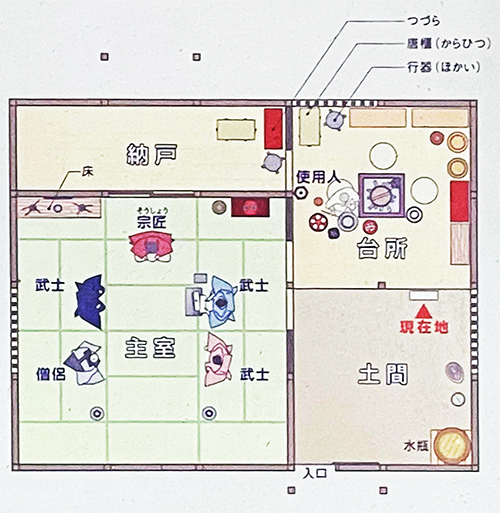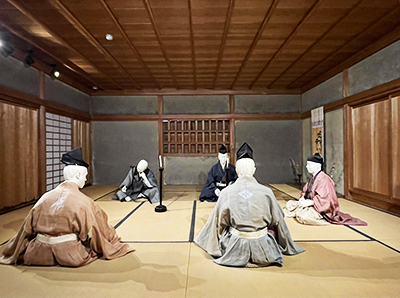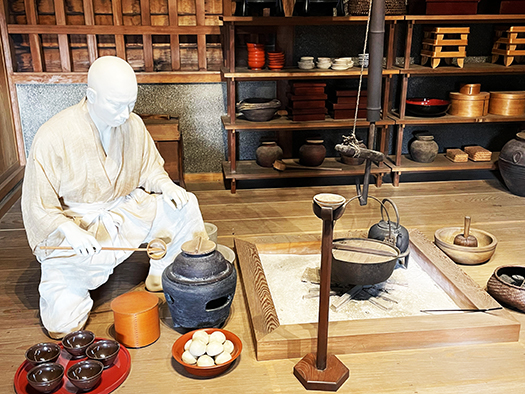


日本史を見渡していて、言語文化コミュニケーションという領域での進化・変容が果たしてきた役割というものは必ずしも明確になっていないというか、あんまり興味は持たれていないと思う。
有名な明智光秀が本能寺直前に開催した連歌の会、というのは有名だけれど、そういった文化は現代社会にまではそのままのカタチではほとんど伝わっていないので、具体的な想像力を持ちにくい。
連歌という文化形式は廃れていったわけだけれど、ではその志向していた方向性って何だったのか、というふうに考えると、どうもわたしには「日本語を発展させる」という要素がもっとも大きな動因だったように思える。
古代人のこころに根ざしていた原日本語というものがあって、そこに律令制度や仏教という世界宗教などの文化受容ということが押し寄せてきた。公文書では漢文の形式が採用されていく社会の趨勢があって、それに対して日本人ネイティブの「こころの表現」という領域がポッカリと空洞になっていたのではないか。
この日本社会の連綿とした「歴史的課題」があって、それに対して日本人の「心性」をあきらかにする文化面での「需要」が底流としてあり続けたのではないだろうか。
連歌というような文化の形式は、そういう主要な志向性を持っていたので、ある程度その目的が達成してくるようになると廃れていって、はるかな後世では明治に至って「言文一致」に基づく「日本文学」の創成で社会目的が達せられ文化継続の動因を失ってしまったのではないだろうか。そんな印象を抱いている。
さて、湯築城城下での「連歌の会」のジオラマ展示。
16世紀中頃の武家屋敷のある日の様子。主室では5人が集って連歌の会を催していた。連歌というのは和歌の上句にあたる「5/7/5」と下の句の「7/7」を交互に読み続けて「百韻(100句)」を完成させるという文化形式。上座に「宗匠」を指導者として招き、式目と呼ばれる約束事を教わりながら、教養力を高めようと必死に「苦吟」している。
挙げ句(最後の一句)に近づいてきてみんな創作に苦心しているけれど、隣室の板の間台所では使用人が連歌を終えた客人に、茶を点てる準備をしている、という情景を復元させている。
古事記の世界の牧歌的な社会から、アジア文化圏世界との交流進化を経て、さまざまな経験知を積み上げていった日本社会の、ある定点での情景ということが言えるのだろう。
どうも一般人としては「そんなメンドイことよりも、美味しそうな団子と茶」のほうに大方の興味は向かっておりました(笑)。苦吟させられた末にようやくふるまわれた茶菓はさぞかし、こころを和ませてくれたに違いない。昔から日本人は花より団子かなぁ、と。
English version⬇
High-class samurai and renga association in Iyo Matsuyama “Yuzuki Castle”-4
The harmony between the common Asian culture and the spirit of the original Japanese people has been needed for a long time. This is one of the forms of the Japanese language cultural movement. The Japanese cultural movement…
Looking around Japanese history, the role played by evolution and transformation in the area of language and cultural communication is not always clear or of much interest.
Although the famous renga (linked verse) gathering held by Akechi Mitsuhide just before Honnoji Temple is well known, it is difficult to imagine such a culture in concrete terms because it has hardly been transmitted to modern society in its original form.
The cultural form of renga has fallen into disuse, but when I think about the direction it was heading in, I think that the most important factor was the “development of the Japanese language”.
The original Japanese language was rooted in the hearts of the ancient people, and the Ritsuryo system and the cultural acceptance of world religions such as Buddhism were pushed into the original Japanese language. In response to the social trend toward the adoption of the Chinese writing system for official documents, the area of “expression of the heart” of the native Japanese was left empty.
This is a continuous “historical issue” in Japanese society, and in response to this, there must have been an underlying “demand” in terms of culture to reveal the “mentality” of the Japanese people.
Since such a cultural form as renga had such a major orientation, it fell into disuse when its purpose was achieved to some extent, and in later generations, it may be that the social purpose was achieved with the creation of “Japanese literature” based on “unanimity of speech and writing” in the Meiji era and lost its driving force for the continuation of culture. Such is my impression.
The diorama exhibition of “Renga no Kai” at the Yuzuki Castle.
A day in a samurai residence in the middle of the 16th century. In the main room, five people gathered to hold a renga (linked verse) party. Renga is a cultural form of waka poetry in which the upper part of the poem, “5/7/5,” and the lower part, “7/7,” are read one after the other to complete “100 rhymes (100 phrases). A “sozai” (master) is invited to the upper section as an instructor, and while being taught a set of rules of engagement called shikimoku, the students “kugin” frantically try to improve their cultural skills.
While everyone is struggling to create a poem as they approach the end of the renga, a servant is preparing to serve tea to the guests who have finished the renga in the itanoma kitchen in the adjoining room.
This is a scene from a fixed point in Japanese society, which has accumulated a variety of experiential knowledge through its evolution from the pastoral society of the Kojiki world to the world of Asian cultures.
As an ordinary person, I was more interested in the delicious dumplings and tea than in such a mendouche (laugh). The tea and sweets that were finally served to the guests must have been very comforting to them. I have always thought that Japanese people are more interested in dumplings than in flowers.
Translated with DeepL.com (free version)
Posted on 3月 31st, 2024 by 三木 奎吾
Filed under: 日本社会・文化研究







コメントを投稿
「※誹謗中傷や、悪意のある書き込み、営利目的などのコメントを防ぐために、投稿された全てのコメントは一時的に保留されますのでご了承ください。」
You must be logged in to post a comment.